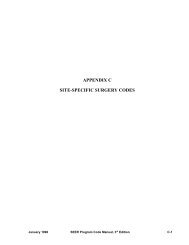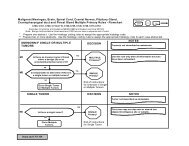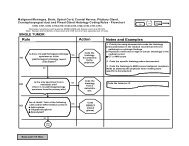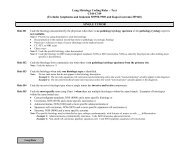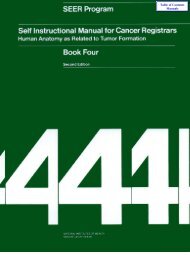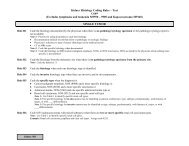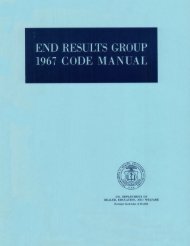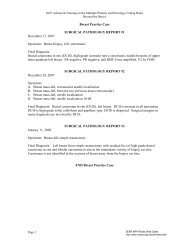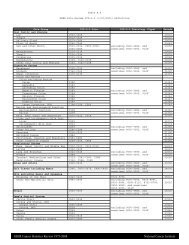Self Instructional Manual for Cancer Registrars - SEER - National ...
Self Instructional Manual for Cancer Registrars - SEER - National ...
Self Instructional Manual for Cancer Registrars - SEER - National ...
Create successful ePaper yourself
Turn your PDF publications into a flip-book with our unique Google optimized e-Paper software.
HOW TO ABSTRACT CANCER REGISTRY INFORMATION<br />
Certain in<strong>for</strong>mation is basic to any abstract, such as the medical record number, diagnosis, date of<br />
diagnosis, age, sex, race, treatment, date of last follow-up, and status of the patient at last follow-up. For a<br />
detailed list of in<strong>for</strong>mation requirements <strong>for</strong> a cancer registry see the Data Acquisition <strong>Manual</strong> of the<br />
Commission on <strong>Cancer</strong>, American College of Surgeons. Other in<strong>for</strong>mation is optional depending upon the<br />
scope of your registry. The detailed description that follows is designed to fit the needs of all users--hospitals,<br />
clinics, and central registry systems.<br />
Patient Identification<br />
Name<br />
Use full name of patient whenever possible. If middle and maiden names are given, record both. Very<br />
often the middle (or maiden) name will be given only as an initial and should be so recorded. However,<br />
every ef<strong>for</strong>t should be made to avoid the use of initials <strong>for</strong> first names.<br />
For married women, the first name of the husband should not be used; record the name of married<br />
female patients, <strong>for</strong> example, as Jones, Paula Ann, not Jones, Mrs. John T. The husband's name will<br />
be recorded under the heading "Spouse."<br />
In recording the name of Catholic clergy, it is preferable to use family names, if known. Use the title<br />
(Sister, Brother, Father, Mother) as a family name only until the true family name is known. A cross<br />
reference will probably be necessary to facilitate this matching of names and avoid duplication.<br />
For male patients who are Sr., Jr., III, etc., so indicate following the last name. Also, if it is known that<br />
the patient has a graduate professional degree (M.D., D.D.S., D.D.), indicate--<strong>for</strong> example, Smith, III,<br />
M.D., Robert Quintin.<br />
Hospital Medical Record Number<br />
Record the number assigned to the patient by the hospital admitting office. If the hospital has a unit<br />
numbering system, all patient records will carry this identifying number. If the hospital has a serial<br />
numbering system, a new number is assigned on each admission to the hospital. In this case each<br />
registry must work out a system which will best serve as a cross reference to the hospital medical record,<br />
<strong>for</strong> example, an alphabetic card index file. This file can then be checked against the medical record<br />
department's alphabetic file to determine the patient's latest admission. You may decide to retain as<br />
your registry number, the number assigned the patient by the hospital at the time the neoplasm was first<br />
diagnosed. If the hospital has a serial unit system, each admission is given a unique number, such as an<br />
accounting number, but the patient's record is filed under a unit number in medical records.<br />
17




